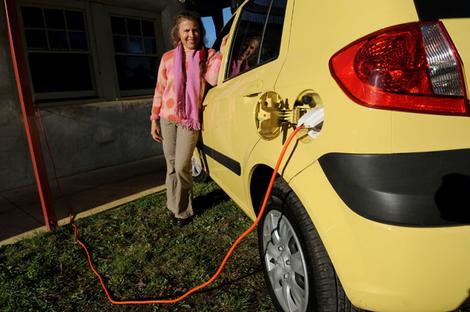Improved battery recharges electric cars faster
 Hamburg - A revolutionary new redox flow battery could make recharging electric cars as easy as filling the fuel tank on conventional cars, according to a team of German scientists.
Hamburg - A revolutionary new redox flow battery could make recharging electric cars as easy as filling the fuel tank on conventional cars, according to a team of German scientists.
If the rechargeable batteries are low, the discharged electrolyte fluid can simply be exchanged at the gas station for recharged fluid - as easy as refilling the petrol tank, say the researchers from the Fraunhofer Institute for Chemical Technology (ICT) in Pfinztal near Karlsruhe, Germany.
Currently, it takes hours to recharge lithium-ion batteries - time that a driver does not have when on the road. The limitations of lithium-ion batteries severely restrict the use of electric cars.
But the scientists see an alternative in redox flow batteries.
"These batteries are based on fluid electrolytes. They can therefore be recharged at the gas station in a few minutes - the discharged electrolyte is simply pumped out and replaced with recharged fluid," says engineer Jens Noack from ICT.
"The pumped-off electrolyte can be recharged at the gas station, for example, using a wind turbine or solar plant," he adds.
The principle of redox flow batteries is not new - two fluid electrolytes containing metal ions flow through porous graphite felt electrodes, separated by a membrane which allows protons to pass through it. During this exchange of charge a current flows over the electrodes, which can be used by a battery powered device.
Until now, however, redox flow batteries have had the disadvantage of storing significantly less energy than lithium-ion batteries. The vehicles would only be able to cover about a quarter of the normal distance - around 25 kilometres (15 miles) - which means the driver would have to recharge the batteries four times as often.
"We can now increase the mileage four- or fivefold to approximately that of lithium-ion batteries," Noack says.
The researchers have already produced the prototype of a cell. Now they must assemble several cells into a battery and optimize them.
This further development is being carried out with colleagues from the University of Applied Sciences, Ostfalia, in Wolfenbuettel and Braunschweig, Germany. They are testing electric drives and energy storage units on model vehicles that are only a tenth of the size of normal vehicles.
The research team has already built a traditional redox flow battery into a model vehicle. A vehicle on a scale of 1:5 was shown in action on a test rig at the eCarTech automotive technology show in Munich recently.
In the coming year the researchers also want to integrate the new battery, with four times greater mileage, into a model vehicle. (dpa)